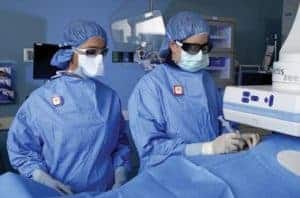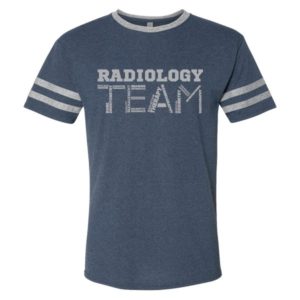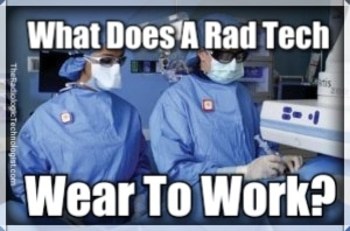Most people are familiar with the typical outfit than many doctors and nurses wear for work: scrubs. But what does a rad tech wear for work? The traditional pale green scrubs have been used in healthcare since the 1950s’. But in radiology, there is a lot more gear worn on a daily basis. So it does make sense for someone outside of healthcare to ask “what does a rad tech wear for work?”
What does a rad tech wear for work?
- Besides scrubs, rad techs wear lead articles of clothing for protection from ionizing radiation.
- We wear lead aprons, thyroid shields and leaded glasses for eye protection. Some procedures place the doctor’s hands directly in the radiation beam so they wear heavy, leaded gloves.
- There are also precautionary items like hair bonnets, face masks, full-face masks with anti-splash shields, shoe booties and full-body “bunny suits.”
- Dosimeter badges are mandatory and worn by every tech to track their personal levels of radiation. Pregnant rad techs wear two dosimeters: one on the upper body and one at the waist.
- Name badges are mandatory in most hospitals and clinics and contain magnetic strips to allow access to the building.
What Color Scrubs Does a Rad Tech Wear to Work?
- This is completely up to the facility where you work. Our national organization, the ARRT, does not have a policy for this.
Some hospitals do segregate their department based on scrub color. The rationale behind this color coding is to help patients identify in a glance what department an employee is from. Although in my experience, this seldom works. Name badges are much more effective in showcasing from what department an employee hails.
At my current hospital, the chosen scrub color for transport is red. Red shirts and tan pants are the sign that you work for the transportation department. I made the mistake one day of wearing a newly purchase red polo and some kacky dress slacks. Throughout the day, people kept looking at me funny.
The only positive to a department having a one color policy, in my opinion, is that employees no longer have to decide what to buy. It is easier for the employee to buy five pairs of blue scrubs than it is to spend time trying to decide which color they are doing to wear for the day.
Scrubs – The Uniform, Not The TV Show

Scrubs are the universal healthcare uniform. I’ve seen a lot of hospitals regulate what color you are allowed to wear. It helps patients to identify what department a hospital employee is from when scrub colors are standardized. It also comes in handy during patient surveys. Patients may not remember the name of the employee who provided care but they might remember the color of their uniform.
Regular scrubs can be purchased from just about everywhere. I’ve seen them at Walmart and Target at really low prices but the quality is low as well. My personal favorites come from the brand Carhartt and can be difficult to find. Expect to pay upwards of $100 for a nice set (top and bottoms). The O.R. scrubs are unisex but for your personal set, consider getting gender-specific. The custom-fit will be more comfortable and the quality will make them last much longer.
What to Wear in The Operating Room
The operating room has its own “surgical scrubs” that get professionally laundered. They are usually a light blue color but can vary. Only the operating room employees are supposed to wear them to save on laundry costs. Radiology techs assigned to work in the O.R. are also required to wear them. You aren’t allowed to wear your “regular” scrubs inside the O.R. because you walk around the hospital in those scrubs. You wore them from home to work and on your lunch break. This opens the opportunity for tracking any germs you picked up along the way to be introduced into the operating room. That is why you always have to change into designated O.R. scrubs when participating in a surgery case. Infection rates are tracked very closely and there is little tolerance for any behavior that can compromise safety.
Radiologic technologists who work in the operating room can be in one case for several hours. During that time, a full-body lead apron is worn. It looks like a vest but extends down to the knees. It can be in one piece or two and can be very heavy. Newer technology is coming out that is taking some of the weight off of these important pieces of protection but not everyone has it yet. Aprons can be styled in any color or pattern and words can be embroidered on them. Most radiologists order their own aprons while technologists tend to share. Last time I checked, one set of lead (top and bottom) cost around $300. They have to be inspected annually with x-rays to look for holes. The apron has to be replaced if the hole is larger than a nickel.
Aside from the lead apron…
Aside from the lead apron, you also have to wear protective barrier clothing for clean environments. You will be wearing protective gear like gloves, a face mask, shoe covers, and a hair bonnet. Sometimes the full-face shields are required in cases that can get messy. A thyroid lead shield is also commonly worn. Studies have shown that the thyroid gland is the most sensitive to radiation. It is second only to the eyeballs. The most radiation conscious surgeons also wear lead glasses for that reason.
You can wear your lead apron on top of your protective clothing or under it. Both ways are commonplace and equally as uncomfortable. In some cases, you wear a full-body suit nicknamed the “bunny suit.” These are light paper full-body pajamas that you step into the legs and zip up the torso after putting your arms in the sleeves. These are helpful in different situations. Usually for sales representatives who need to be in a case assisting the doctor and they just leave their normal clothes on under the bunny suit. Any time an inspector comes for a visit, they put one of these on instead of changing in and out of scrubs.
What does a rad tech wear for work in the Critical Care Units
This is where you see a lot of red-colored precaution carts. These carts are placed outside of patient rooms who have a reason to be isolated from the general public. The carts carry everything you need to protect yourself and the patient from contamination. Yellow jacks that look like a laboratory jacket are used while inside the room. They are discarded upon leaving unless you are the nurse assigned to be with the patient all day. These nurses sometimes hang the jackets just inside the room door for reuse.
The carts also have boxes of gloves, face masks, and other barrier gear. A sign on the room will tell you what type of precaution to prepare for and what to wear.
What does a rad tech wear for work in the Interventional Radiology Unit
This is similar to the operating room but is located in the imaging department. A radiologist performs the procedures with the aid of techs and nurses. The same gear is expected to be worn here as in the O.R. As time goes by, the IR lab is being treated more and more like the operating room in terms of consent requirements, time-out pauses, marking for laterality and so on. The same goes for keeping a sterile environment.
In the operating room, nurses help gown up the surgeons or they are helped by the person assisting them. In interventional radiology, the technologist is often the person to help the radiologist gown up. The interventional technologist gets the room set up before the radiologist arrives. The tech opens the procedure tray and sets out the items needed to perform the procedure. When the radiologist enters, he talks with the patient and then proceeds to gown up with the help of the tech. Radiology departments often have their own nurses and they will help if in the room. Not all interventional procedures require a nurse to be present.
Tech Favorites: NRTW T-Shirts

Our favorite attire of all is the coveted RT Week t-shirt. Every year we celebrate the invention of the Xray by Wilhelm Roentgen. Wilhelm discovered the x-ray on Nov 8, 1898. National Radiologic Technology Week or NRTW is celebrated for the entire week in imaging departments around the world. I still have shirts that were given out at RT week over ten years ago. We keep them professional with references to radiology. There is usually radiology artwork on the shirt somewhere too.
I have always allowed staff to wear these shirts to work with their scrub pants. It helps lift team morale and express pride in our work.
I hope this helps shed some light on what we wear in our line of work. If I have forgotten something just leave it in the comment section below.
Additional Information:
If you are curious about the career of radiography, I have written some articles on various topics:

